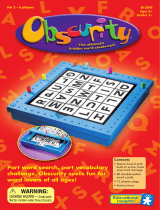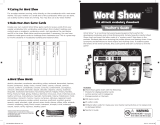Page is loading ...

Includes:
26 Letter tiles
108 Category cards
Sand timer
Game board
Guide
Quick-Play Variation
Playing in a classroom or other setting where time is limited? No
problem! Simply set a time limit and if neither team has captured eight
letter tiles by that time, the team that has captured the most letter tiles
wins! lf there is a tie, compare how many letter tiles each team has in the
lane closest to their side of the street. Keep track of which team went
rst and nish the game with the other team so that both have an equal
number of turns on the street.
Family Variation for Younger Players
Word on the Street Junior can be played with children under seven years
of age, as long as they are on a team with at least one adult. Younger
players can ip over category cards, be the timekeeper, and offer word
suggestions. They can be part of the team and will learn how to master
the game!
The Object of the Game
Capture letter tiles by selecting words that
contain the desired letters and pulling the
letters off the street before the opposing
team can pull them back. The rst team to
capture eight letter tiles wins.
Example:
The Wacky Tug of Words
Team A
EI-2831
Ages 7 to Adult
2–8 Players
Team B
Team B selects the word PURPLE—
1. P is announced and moved one space.
2. U is announced and moved one space.
3. R is announced, moved one space, and is
captured by Team B.
4. P is announced again and moved one more
space.
5. L is announced but not moved since it has
already been captured.
6. E is announced and moved one space.
L and Y have
already been
captured by
Team A
F and M have
already been
captured by
Team B

Setup
1. Divide the players into two teams.
2. Place the game board between the two teams, as
shown on the right.
3. Place each letter tile on the corresponding letter in
the middle of the game board.
4. Place the category cards in the card holder. Select
which side of the category cards will be used for
the game. Orange side cards are more challenging
than the blue side.
5. Place the timer and the card tray at one end of the
game board, within reach of both teams.
6. Determine which team will take the rst turn.
Playing the Game
Teams alternate taking turns “on the street” until one team has captured eight
letter tiles. A turn on the street consists of the following ve steps:
1. A player from the team on the street draws the rst card from the card tray,
places it on the table with the selected color facing up, and reads the category
aloud. As the card is drawn, a player from the opposing team ips over the
timer.
2. Players from the team on the street brainstorm words that t the category
printed on the category card. Team members may call out as many suggestions
as they want, but must agree on one word that ts the category before time
runs out. The team should consider the suggestions of all team members
before choosing the word. (See Allowable Words.)
3. After the time runs out, one player from the team on the street moves the
letter tiles for the selected word. There is no time limit during this part of the
game. All players should help to correctly spell the word. A dictionary or other
reference material may be used. (See Moving the Tiles.)
4. When the letter tiles have been moved, that team’s turn is over and the
category card is placed in the back of the card tray.
5. The opposing team becomes the new team on the street and begins their turn
with Step 1.
Aowable Words
Word selections must be in the form of a single word. Any word in the
English language is allowed, including words that are capitalized, such as
the names of persons and places. Singular and plural forms of words are
both allowed as long as the selected word ts the category named on the
category card. For example, “sprinkles” would be allowed for the category
card “An ice cream topping” because sprinkles are generally considered
one topping. However, “caramels” would not be allowed because it is
commonly written as “caramel” when listed as an ice cream topping. Only
present tense forms of words may be used. For example, “play” would be
allowed for the category card “Something people do at the park”. However,
the word “played” would not since it is in the past tense. Hyphenated and
compound words are allowed because they are considered single words. For
example, “sandbox” is allowed because it’s a single word, but “sand dollar”
is not allowed because it is two words.
Chaenging a Word Selection or Speing
During the brainstorming phase of the game, players from either team
are free to suggest any words they wish. After the time is up and the tiles
have been moved, if the opposing team thinks that the team on the street
has made an error in either spelling or word selection, they may raise a
“challenge.” A challenge may result in either the team on the street having
to move tiles back or the team raising the challenge losing its next turn—so
choose your challenges wisely.
Spelling, hyphenated words, and compound word challenges:
All players should work together to attempt to determine if the selection
is a single word and is spelled correctly. lf the dispute is not resolved by
consensus, a dictionary or other reference may be used.
• lf the spelling is found to be correct, the letter tiles remain in their new
positions and the team raising the challenge loses their next turn.
• lf the spelling is found to be incorrect, all tiles moved in error should return
to their previous positions.
• lf the selection is in fact two words rather than a compound word or a
hyphenated word, then all letter tiles for that word are moved back to their
previous positions.
Word Selection Chaenge
lf the opposing team challenges a word selection, the team on the street
must explain why they believe their selection ts the category on the card. lf
a majority of the players accept the explanation, the letter tiles remain in their
new positions. lf a majority of the players reject the explanation, all letter tiles
for the word are returned to their previous positions. lf there is a tie, the letter
tiles for the word are returned to their previous positions and the team on the
street restarts their turn with a new card.
Moving the Tiles
Each letter tile is moved one space, toward the team on the street, for each time
that letter appears in the selected word. See the example below.
• Member(s) of the team on the street spell the word aloud and the tiles are
moved, in order, as the letters are announced.
• Only one player from the team on the street moves the letter tiles per turn.
• The opposing team is not allowed to move tiles.
• lf a team m
oves a letter tile off the board on their side of the street, that
team has captured that tile.
Captured letter tiles never move back onto the street.
•
Teams may select words that include letters that have been captured, but the
captured letter tiles are not moved.
• Captu
red letter tiles remain next to the board to show how many tiles each
team has captured.
/










